Pumping Station Desing - Second Edition by Robert L. Sanks, George Tchobahoglous, Garr M. Jones
Подождите немного. Документ загружается.

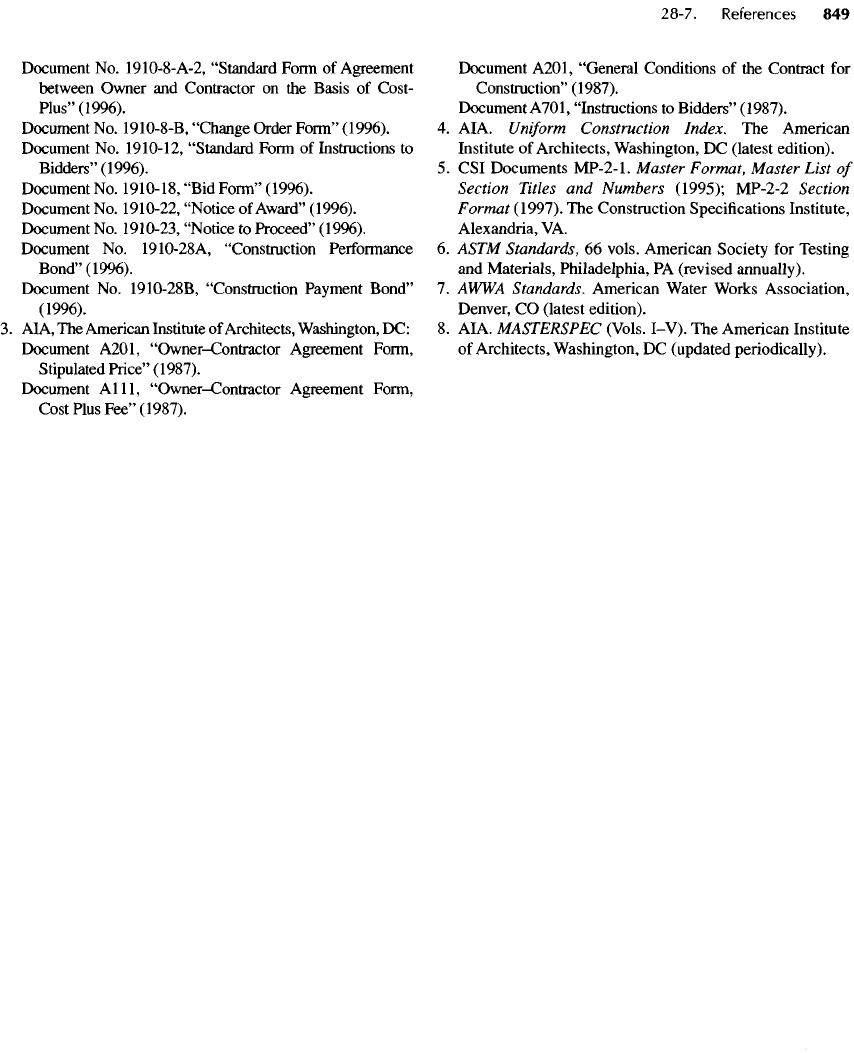
Document
No.
1910-8-A-2,
"Standard Form
of
Agreement
between
Owner
and
Contractor
on the
Basis
of
Cost-
Plus" (1996).
Document
No.
1910-8-B,
"Change Order Form" (1996).
Document
No.
1910-12,
"Standard Form
of
Instructions
to
Bidders" (1996).
Document
No.
1910-18,
"Bid Form" (1996).
Document
No.
1910-22, "Notice
of
Award" (1996).
Document
No.
1910-23,
"Notice
to
Proceed"
(1996).
Document
No.
19
10-28
A,
"Construction Performance
Bond" (1996).
Document
No.
1910-28B,
"Construction Payment Bond"
(1996).
3.
AIA,
The
American Institute
of
Architects, Washington,
DC:
Document
A201,
"Owner-Contractor
Agreement Form,
Stipulated
Price"
(1987).
Document
AlIl,
"Owner-Contractor
Agreement Form,
Cost Plus Fee" (1987).
Document A201,
"General
Conditions
of the
Contract
for
Construction" (1987).
Document
A701, "Instructions
to
Bidders" (1987).
4.
AIA.
Uniform
Construction Index.
The
American
Institute
of
Architects, Washington,
DC
(latest edition).
5. CSI
Documents
MP-2-1.
Master Format, Master List
of
Section
Titles
and
Numbers
(1995);
MP-2-2 Section
Format
(1997).
The
Construction Specifications Institute,
Alexandria,
VA.
6.
ASTM
Standards,
66
vols.
American Society
for
Testing
and
Materials, Philadelphia,
PA
(revised annually).
7.
AHWA
Standards. American Water Works Association,
Denver,
CO
(latest edition).
8.
AIA.
MASTERSPEC
(Vols.
I-V).
The
American Institute
of
Architects, Washington,
DC
(updated periodically).
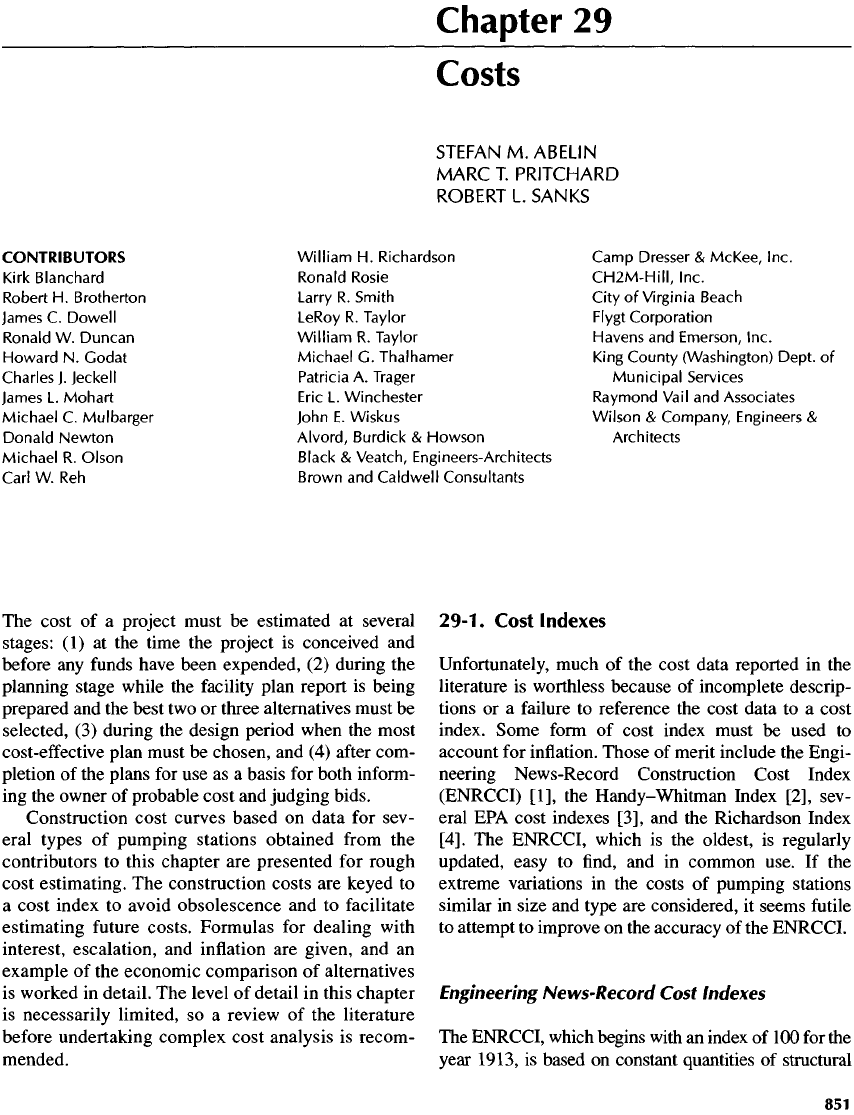
The
cost
of a
project must
be
estimated
at
several
stages:
(1) at the
time
the
project
is
conceived
and
before
any
funds
have been expended,
(2)
during
the
planning
stage while
the
facility
plan report
is
being
prepared
and the
best
two or
three alternatives must
be
selected,
(3)
during
the
design period when
the
most
cost-effective
plan must
be
chosen,
and (4)
after
com-
pletion
of the
plans
for use as a
basis
for
both inform-
ing
the
owner
of
probable cost
and
judging bids.
Construction
cost
curves based
on
data
for
sev-
eral types
of
pumping stations obtained
from
the
contributors
to
this chapter
are
presented
for
rough
cost estimating.
The
construction costs
are
keyed
to
a
cost index
to
avoid obsolescence
and to
facilitate
estimating
future
costs. Formulas
for
dealing with
interest, escalation,
and
inflation
are
given,
and an
example
of the
economic comparison
of
alternatives
is
worked
in
detail.
The
level
of
detail
in
this chapter
is
necessarily limited,
so a
review
of the
literature
before
undertaking complex cost analysis
is
recom-
mended.
29-1.
Cost
Indexes
Unfortunately,
much
of the
cost data reported
in the
literature
is
worthless because
of
incomplete descrip-
tions or a
failure
to
reference
the
cost data
to a
cost
index. Some
form
of
cost index must
be
used
to
account
for
inflation.
Those
of
merit include
the
Engi-
neering News-Record Construction Cost Index
(ENRCCI) [1],
the
Handy-Whitman Index [2], sev-
eral
EPA
cost
indexes [3],
and the
Richardson Index
[4].
The
ENRCCI, which
is the
oldest,
is
regularly
updated, easy
to find, and in
common use.
If the
extreme variations
in the
costs
of
pumping stations
similar
in
size
and
type
are
considered,
it
seems
futile
to
attempt
to
improve
on the
accuracy
of the
ENRCCI.
Engineering
News-Record
Cost
Indexes
The
ENRCCI, which begins with
an
index
of 100 for the
year
1913,
is
based
on
constant quantities
of
structural
Chapter
29
Costs
STEFAN
M.
ABELIN
MARC
T.
PRITCHARD
ROBERT
L.
SANKS
CONTRIBUTORS
William
H.
Richardson Camp
Dresser
&
McKee,
Inc.
Kirk
Blanchard Ronald
Rosie
012M-HiII,
Inc.
Robert
H.
Brotherton
Larry
R.
Smith
City
of
Virginia
Beach
James
C.
Dowel
I
LeRoy
R.
Taylor
Flygt
Corporation
Ronald
W.
Duncan
William
R.
Taylor Havens
and
Emerson,
Inc.
Howard
N.
Godat
Michael
G.
Thalhamer
King
County
(Washington)
Dept.
of
Charles
J.
Jeckell Patricia
A.
Trager
Municipal
Services
James
L.
Mohart
Eric
L.
Winchester Raymond Vail
and
Associates
Michael
C.
Mulbarger
John
E.
Wiskus
Wilson
&
Company,
Engineers
&
Donald
Newton
Alvord,
Burdick
&
Howson
Architects
Michael
R.
Olson
Black
&
Veatch, Engineers-Architects
Carl
W. Reh
Brown
and
Caldwell
Consultants
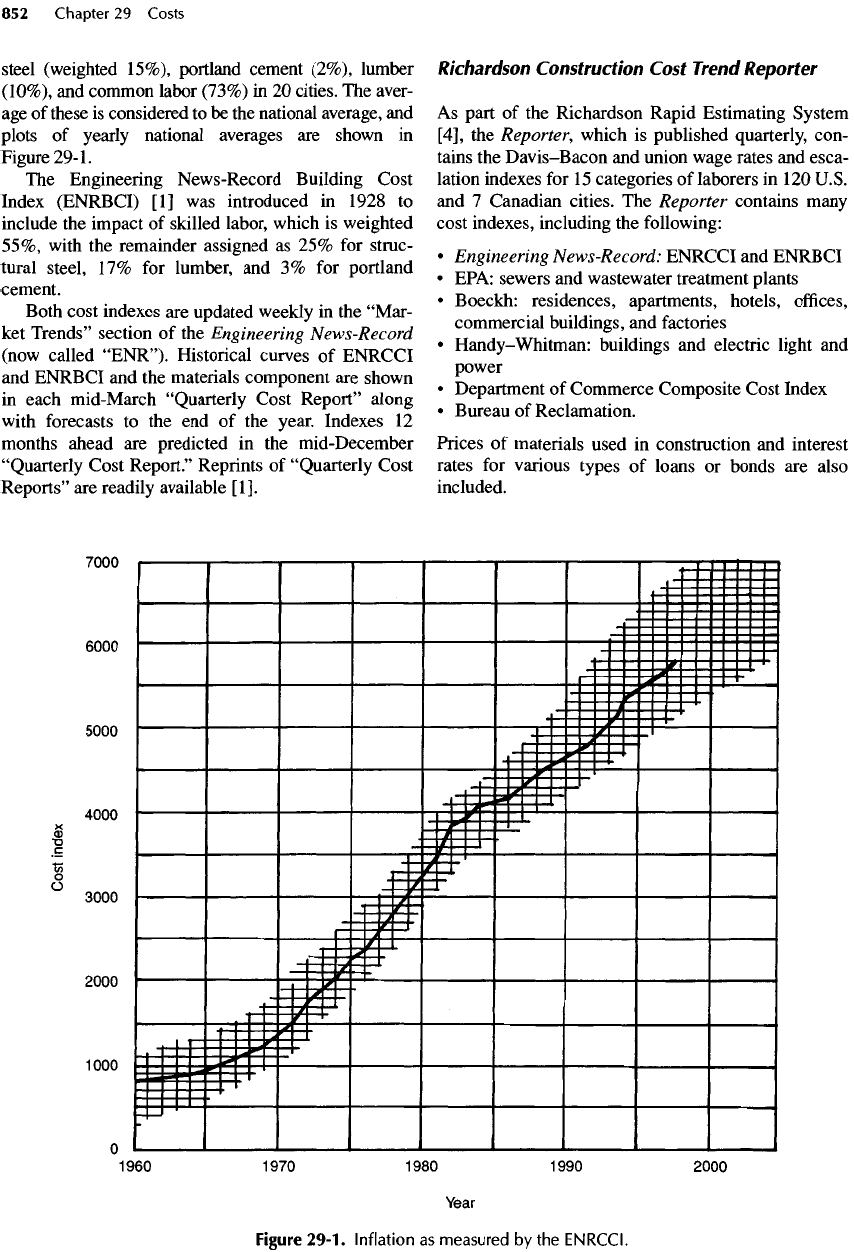
steel (weighted 15%),
portland
cement (2%), lumber
(10%),
and
common labor (73%)
in 20
cities.
The
aver-
age
of
these
is
considered
to be the
national average,
and
plots
of
yearly national averages
are
shown
in
Figure
29-1.
The
Engineering News-Record Building Cost
Index
(ENRBCI)
[1] was
introduced
in
1928
to
include
the
impact
of
skilled labor, which
is
weighted
55%,
with
the
remainder assigned
as 25% for
struc-
tural
steel,
17% for
lumber,
and 3% for
portland
cement.
Both
cost indexes
are
updated weekly
in the
"Mar-
ket
Trends" section
of the
Engineering News-Record
(now
called
"ENR").
Historical curves
of
ENRCCI
and
ENRBCI
and the
materials component
are
shown
in
each mid-March "Quarterly Cost
Report"
along
with
forecasts
to the end of the
year. Indexes
12
months
ahead
are
predicted
in the
mid-December
"Quarterly Cost
Report."
Reprints
of
"Quarterly Cost
Reports"
are
readily available
[I].
Richardson
Construction
Cost
Trend
Reporter
As
part
of the
Richardson Rapid Estimating System
[4],
the
Reporter,
which
is
published quarterly, con-
tains
the
Davis-Bacon
and
union wage rates
and
esca-
lation indexes
for 15
categories
of
laborers
in 120
U.S.
and
7
Canadian cities.
The
Reporter contains many
cost indexes, including
the
following:
•
Engineering
News-Record:
ENRCCI
and
ENRBCI
•
EPA: sewers
and
wastewater treatment plants
•
Boeckh:
residences, apartments, hotels,
offices,
commercial buildings,
and
factories
•
Handy-Whitman: buildings
and
electric
light
and
power
•
Department
of
Commerce Composite Cost Index
•
Bureau
of
Reclamation.
Prices
of
materials used
in
construction
and
interest
rates
for
various types
of
loans
or
bonds
are
also
included.
Figure
29-1.
Inflation
as
measured
by the
ENRCCI.
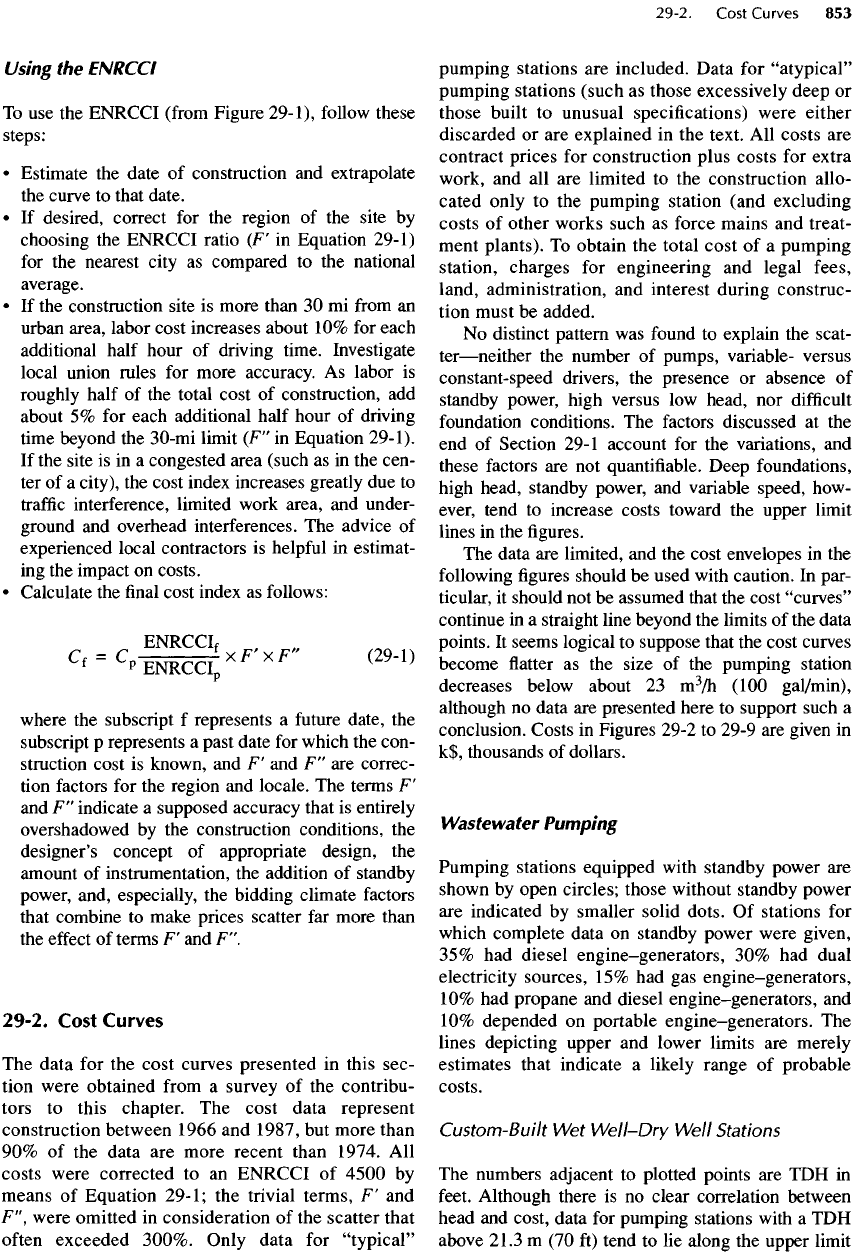
Using
the
ENRCCI
To
use the
ENRCCI
(from
Figure 29-1),
follow
these
steps:
•
Estimate
the
date
of
construction
and
extrapolate
the
curve
to
that date.
• If
desired, correct
for the
region
of the
site
by
choosing
the
ENRCCI ratio
(F'
in
Equation 29-1)
for
the
nearest city
as
compared
to the
national
average.
• If the
construction site
is
more than
30 mi
from
an
urban
area, labor cost increases about
10%
for
each
additional half hour
of
driving time. Investigate
local union rules
for
more accuracy.
As
labor
is
roughly half
of the
total cost
of
construction,
add
about
5% for
each additional half hour
of
driving
time
beyond
the
30-mi limit
(F" in
Equation 29-1).
If
the
site
is in a
congested area (such
as in the
cen-
ter of a
city),
the
cost index increases greatly
due to
traffic
interference, limited work area,
and
under-
ground
and
overhead interferences.
The
advice
of
experienced
local
contractors
is
helpful
in
estimat-
ing
the
impact
on
costs.
•
Calculate
the final
cost index
as
follows:
ENRCCL
C
f
=
C
PENRCCi;
XFxF
(2<M)
where
the
subscript
f
represents
a
future
date,
the
subscript
p
represents
a
past date
for
which
the
con-
struction cost
is
known,
and
F'
and F" are
correc-
tion
factors
for the
region
and
locale.
The
terms
F'
and
F"
indicate
a
supposed accuracy that
is
entirely
overshadowed
by the
construction conditions,
the
designer's concept
of
appropriate design,
the
amount
of
instrumentation,
the
addition
of
standby
power,
and,
especially,
the
bidding climate
factors
that
combine
to
make prices scatter
far
more than
the
effect
of
terms
F'
and F".
29-2.
Cost
Curves
The
data
for the
cost curves presented
in
this
sec-
tion were obtained
from
a
survey
of the
contribu-
tors
to
this chapter.
The
cost data represent
construction
between
1966
and
1987,
but
more than
90%
of the
data
are
more recent than
1974.
All
costs were corrected
to an
ENRCCI
of
4500
by
means
of
Equation
29-1;
the
trivial terms,
F'
and
F",
were omitted
in
consideration
of the
scatter that
often
exceeded
300%.
Only data
for
"typical"
pumping
stations
are
included. Data
for
"atypical"
pumping
stations (such
as
those excessively deep
or
those
built
to
unusual specifications) were either
discarded
or are
explained
in the
text.
All
costs
are
contract
prices
for
construction plus costs
for
extra
work,
and all are
limited
to the
construction
allo-
cated only
to the
pumping station
(and
excluding
costs
of
other
works such
as
force mains
and
treat-
ment plants).
To
obtain
the
total cost
of a
pumping
station, charges
for
engineering
and
legal fees,
land, administration,
and
interest during construc-
tion must
be
added.
No
distinct pattern
was
found
to
explain
the
scat-
ter
—
neither
the
number
of
pumps, variable- versus
constant-speed drivers,
the
presence
or
absence
of
standby
power, high versus
low
head,
nor
difficult
foundation
conditions.
The
factors
discussed
at the
end of
Section
29-1
account
for the
variations,
and
these factors
are not
quantifiable.
Deep
foundations,
high
head, standby power,
and
variable speed, how-
ever,
tend
to
increase costs toward
the
upper limit
lines
in the figures.
The
data
are
limited,
and the
cost envelopes
in the
following
figures
should
be
used with caution.
In
par-
ticular,
it
should
not be
assumed that
the
cost
"curves"
continue
in a
straight line beyond
the
limits
of the
data
points.
It
seems logical
to
suppose that
the
cost curves
become
flatter as the
size
of the
pumping station
decreases below about
23
m
3
/h
(100
gal/min),
although
no
data
are
presented
here
to
support such
a
conclusion. Costs
in
Figures 29-2
to
29-9
are
given
in
k$,
thousands
of
dollars.
Wastewater
Pumping
Pumping
stations
equipped
with standby power
are
shown
by
open circles; those without standby power
are
indicated
by
smaller solid dots.
Of
stations
for
which
complete data
on
standby power were given,
35%
had
diesel
engine-generators,
30% had
dual
electricity sources,
15% had gas
engine-generators,
10%
had
propane
and
diesel
engine-generators,
and
10%
depended
on
portable
engine-generators.
The
lines
depicting upper
and
lower limits
are
merely
estimates that indicate
a
likely range
of
probable
costs.
Custom-Built
Wet
Well-Dry Well Stations
The
numbers adjacent
to
plotted points
are TDH in
feet.
Although there
is no
clear correlation between
head
and
cost, data
for
pumping stations with
a TDH
above 21.3
m
(70 ft)
tend
to lie
along
the
upper limit

of
costs
in
Figure 29-2.
Of the
three points well above
the
upper limit,
one is for a
station (TDH
= 47)
that
required automatic screens, odor control, and, during
construction, blasting. Another
is for a
station
(TDH
= 55)
that included comminutors,
chlorination
equipment,
and
provision
for
future
telemetering.
The
third station (TDH
= 38) had
odor-control equipment
and
room
to
increase
the
number
of
pumps
from
four
to
six.
The
cluster
of 25
points
at the
lower
left
is for
one
location, Virginia Beach, where nearly
all of the
pumping stations were built
by
developers
to
city
requirements.
Submersible
Pumps
The TDH for
half
of the
stations
is
less than 15.2
m
(50
ft). Data points
for all but two
stations with
a TDH
of
more than
15.2
m (50 ft) lie
close
to or
above
the
upper
limit line shown
in
Figure 29-3.
Self-Priming
Pumps
No
data
are
shown
for
self-priming pumps
at
grade,
but
construction cost
is
slightly less than
for
submers-
ible pumps.
The
maintenance
of
self
-priming
pumps
is
lower than that
for
submersible pumps because
the
equipment
is at
grade,
the
access
is
easy,
the wet
well
can
be
sealed
so
that there
are no
fumes
to
corrode
electrical equipment,
and
there
is no
need
for
ventila-
tion other than louvers
for
cooling
the
motors
[5].
Prefabricated
Pumping Stations
Prefabricated pumping stations
can be
obtained
in a
number
of
types:
(1) wet
well-dry
well with flooded
suction
—
that
is, the dry
well
is as
deep
as the wet
well;
(2) wet
well-shallow
dry
well with suction
lift;
(3)
wet
well with
a
submerged pump connected
to the
motor with
a
long
shaft;
(4) wet
well with suction
lift
Figure
29-2.
Construction
costs
of
custom
wet
well-dry
well
wastewater
pumping
stations.
No
standby
power
=
solid
circles,
has
standby
power
=
open
circles.
The
numbers
are TDH in
feet.

Figure
29-3. Construction
costs
of
submersible-pump wastewater
pumping
stations.
No
standby
power
=
solid cir-
cles,
has
standby
power
=
open
circles.
The
numbers
are TDH in
feet.
to
self-priming
pumps
at
grade;
and (5)
submersible
pump
and
close-coupled (submersible) motor.
The
data
for
prefabricated pumping stations
in
Figure 29-4
are for the wet
well-dry
well type except
for
two,
which
utilize
self-priming
pumps,
and
one, which
is an
enclosed (Archimedes) screw pump. With
one
excep-
tion,
the
variation
in
heads does
not
affect
the
costs.
The
high cost
of one
pumping station
is due to the
inclusion
of
headworks (comminutor, Parshall
flume,
manual
screen bypass).
The
Archimedes screw pump
is
included with prefabricated stations because
it is an
enclosed screw and, thus,
"prefabricated"
to a
degree.
Water
Pumping
In
general, high speed (1800
rev/min)
is
common
up
to 150 kW
(200 hp),
and
1200 rev/min
is
usual
for
larger pumps.
Raw
Water
Pumping
All of the
pumping stations shown
in
Figure 29-5 were
constructed
in
lakes
or on the
banks
of
rivers where
deep structures, sheet piling,
or
coffer
dams were
required.
The
high cost
of
pumping station
no. 1 is
attributed
(1)
partly
to
facilities designed
for two
pumps
with
space
for
four
more
and a
dual electrical feeder
for
standby
power
and (2)
partly
to
minimal
bid
competi-
tion
and the
construction
of a
lake intake. Pumping sta-
tions nos.
3 and 4
have traveling screens,
no. 3 has a
massive
(3.3-m-
or
11-ft-thick)
foundation
of
tremie
concrete,
and no. 4 has
prestressed rock anchors.
The TDH
varied
from
15.8
to 73
m
(52 to 240 ft). The
stations with
the
lowest relative cost (nos.
2 and 6) had
nearly
the
highest
and
lowest heads, whereas
the
stations
with
highest relative costs (nos.
1, 3, 4, and 5)
also
had
the
lowest (no.
1) to the
highest (no.
5)
heads. Head
is
evidently
a
minor consideration
in raw
water pumping.
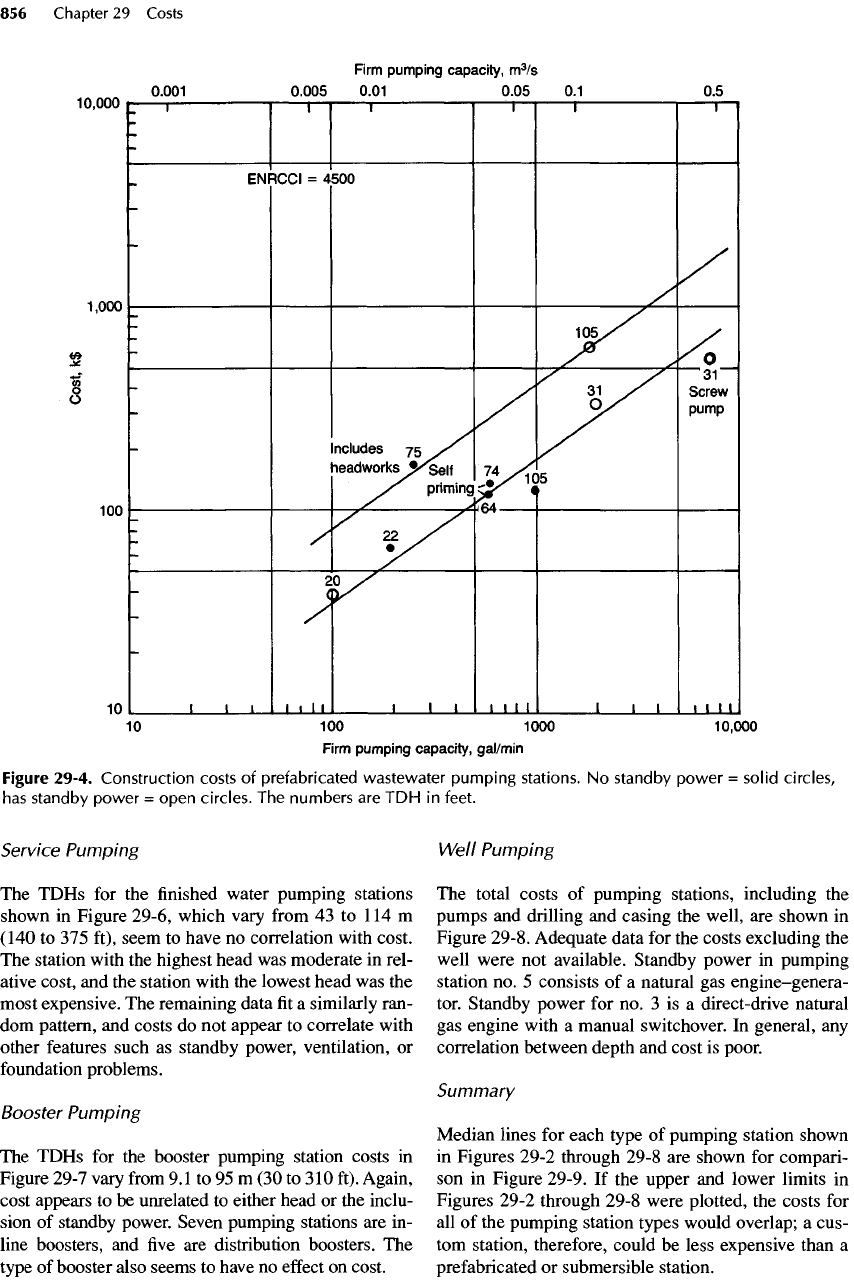
Service
Pumping
The
TDHs
for the
finished
water pumping stations
shown
in
Figure 29-6, which vary
from
43 to
1
14
m
(140
to 375
ft), seem
to
have
no
correlation with cost.
The
station with
the
highest head
was
moderate
in
rel-
ative
cost,
and the
station with
the
lowest head
was the
most
expensive.
The
remaining data
fit a
similarly ran-
dom
pattern,
and
costs
do not
appear
to
correlate with
other
features
such
as
standby power, ventilation,
or
foundation
problems.
Booster
Pumping
The
TDHs
for the
booster pumping station costs
in
Figure
29-7
vary
from
9.1
to 95 m (30 to 310
ft). Again,
cost appears
to be
unrelated
to
either head
or the
inclu-
sion
of
standby power. Seven pumping stations
are in-
line
boosters,
and five are
distribution boosters.
The
type
of
booster also seems
to
have
no
effect
on
cost.
Well
Pumping
The
total costs
of
pumping stations, including
the
pumps
and
drilling
and
casing
the
well,
are
shown
in
Figure 29-8. Adequate data
for the
costs excluding
the
well were
not
available. Standby power
in
pumping
station
no. 5
consists
of a
natural
gas
engine-genera-
tor. Standby power
for no. 3 is a
direct-drive natural
gas
engine with
a
manual switchover.
In
general,
any
correlation between depth
and
cost
is
poor.
Summary
Median lines
for
each type
of
pumping station shown
in
Figures 29-2 through 29-8
are
shown
for
compari-
son
in
Figure 29-9.
If the
upper
and
lower limits
in
Figures 29-2 through 29-8 were plotted,
the
costs
for
all of the
pumping station types would overlap;
a
cus-
tom
station, therefore, could
be
less expensive than
a
prefabricated
or
submersible station.
Figure
29-4. Construction
costs
of
prefabricated wastewater
pumping
stations.
No
standby
power
=
solid
circles,
has
standby
power
=
open
circles.
The
numbers
are TDH in
feet.

If
the
cost
for one
size (capacity)
of a
pumping sta-
tion
is
known,
the
cost
for
another size
(of the
same
type)
can be
found
by
means
of the
"six
-tenths
factor."
Simply
multiply
the
known cost
for one
facility
by the
ratio
of
sizes raised
to the
exponent 0.6.
For
most
of
the
plots
of
Figure 29-9, however,
a
more realistic
exponent
is
0.75.
For
water wells,
the
exponent
is
about
0.42.
29-3.
Maintenance
and
Energy
The
cost
for
maintenance
is
elusive partly because
(1)
it
depends upon
the
owners' policies, which vary
greatly
from
utility
to
utility (and
also
with
time
and
personnel)
and (2) so few
owners have reliable, accu-
rate records
of
maintenance labor
and
supplies
for
each pumping
station.
Because pumping stations dif-
fer
considerably
in
maintenance requirements,
records
for
several stations lumped together
are of
lit-
tle
use.
The
true cost
of
labor should include
fringe
benefits,
supervision, costs
for
support (tools, vehi-
cles, insurance, etc.),
and the
expenses associated
with
maintaining support facilities such
as
shops,
clerks, records, etc. Costs
of
operating
and
mainte-
nance
labor,
material,
and
supplies
for
wastewater
pumping
are
shown
as
curves
by
Patterson
and
Banker [6],
but
these data should
be
used with cau-
tion because
(1)
labor
time
can
easily
be
double
the
values shown
and (2)
there
is no
correlation with
owners'
policies
or
types
of
stations.
Maintenance
of
equipment
is
also
equipment spe-
cific.
For
example,
the
maintenance
for a
wound-rotor
motor with
its
brushes
and
slip rings
is
much greater
than
for a
squirrel-cage
motor.
A
self-priming pump
can be
repaired
by the
maintenance crew, but,
to
pre-
vent
voiding
the
contractor's guarantee,
a
submersible
pump
might have
to be
shipped
to a
service center with
shipping
costs added
to the
high (perhaps
30% of the
original purchase price) cost
of
repair. Repairs made
to
Figure 29-5.
Construction
costs
of
prefabricated wastewater
pumping
stations.
No
standby
power
=
solid
circles,
has
standby
power
=
open
circles.
The
numbers
are TDH in
feet.

any
equipment
at the job
site
by
factory-authorized
service
personnel
are
likely
to be
extremely expensive,
but
rational maintenance costs
can be
assessed
by
investigating
service contracts.
Excessive
dependence
on the
effect
of
either
size
or
purchase price
in
estimating maintenance costs
is
unwise.
For
example,
the
maintenance costs
for a
large pump might actually
be
less than
for a
small,
less expensive pump because
of
better accessibility
(and,
hence, reduced labor time, e.g.,
for
replacing
packing)
and
because
of the
lower speed
of the
larger
pump.
Finally,
two
identical machines
in
similar cir-
cumstances
may
have, inexplicably, quite
different
maintenance needs
and
costs. However,
to
ignore
maintenance
costs because they
are
difficult
to
evalu-
ate is to
skew cost comparisons
and
decisions.
To put
it
simply, investigate
as
necessary
and do the
best
you
can.
Some equipment (such
as
solid-state electronic
controls) become
obsolete,
so a
sinking
fund
to
replace such items
in a
reasonable period (say,
8 to 15
yr
for
electronic equipment) should
be
added
to
annual
maintenance costs.
Pumping
station design
is (or
should
be)
pro-
foundly
influenced
by the
cost
of
power. Dealing with
energy
costs
can be
very
complex.
Electric
power
rates vary with
the
classification
of the
user,
the
amount
of
power used, and,
often,
with
the
time
of
day,
the
season
of the
year,
the
power factor,
and the
power
demand.
The
rates
differ
by as
much
as
500%
or
more depending
on
location. Furthermore,
the
esca-
lation
of
cost
may
exceed, keep pace with,
or
even
lag
behind
inflation.
The
costs
of
natural
gas and
diesel
fuel
are
less complex
and
subject
to
fewer
influences,
but
they still depend
on
location
and
politics.
Electric
power
and gas
utilities
are the
most
reliable
source
of
information
on
past
and
present costs
of
electricity
and
gas. Some utilities make
careful
predictions
of
future
power costs.
For
critical problems,
a
good pro-
cedure
is to
present
the
appropriate utility with
a
com-
plete spectrum
of
power needs
and let
them calculate
Figure 29-6.
Construction
costs
of
service
water
pumping
stations.
No
standby
power
=
solid
circles,
has
standby
power
=
open
circles.
The
numbers
are the TDH in
feet.
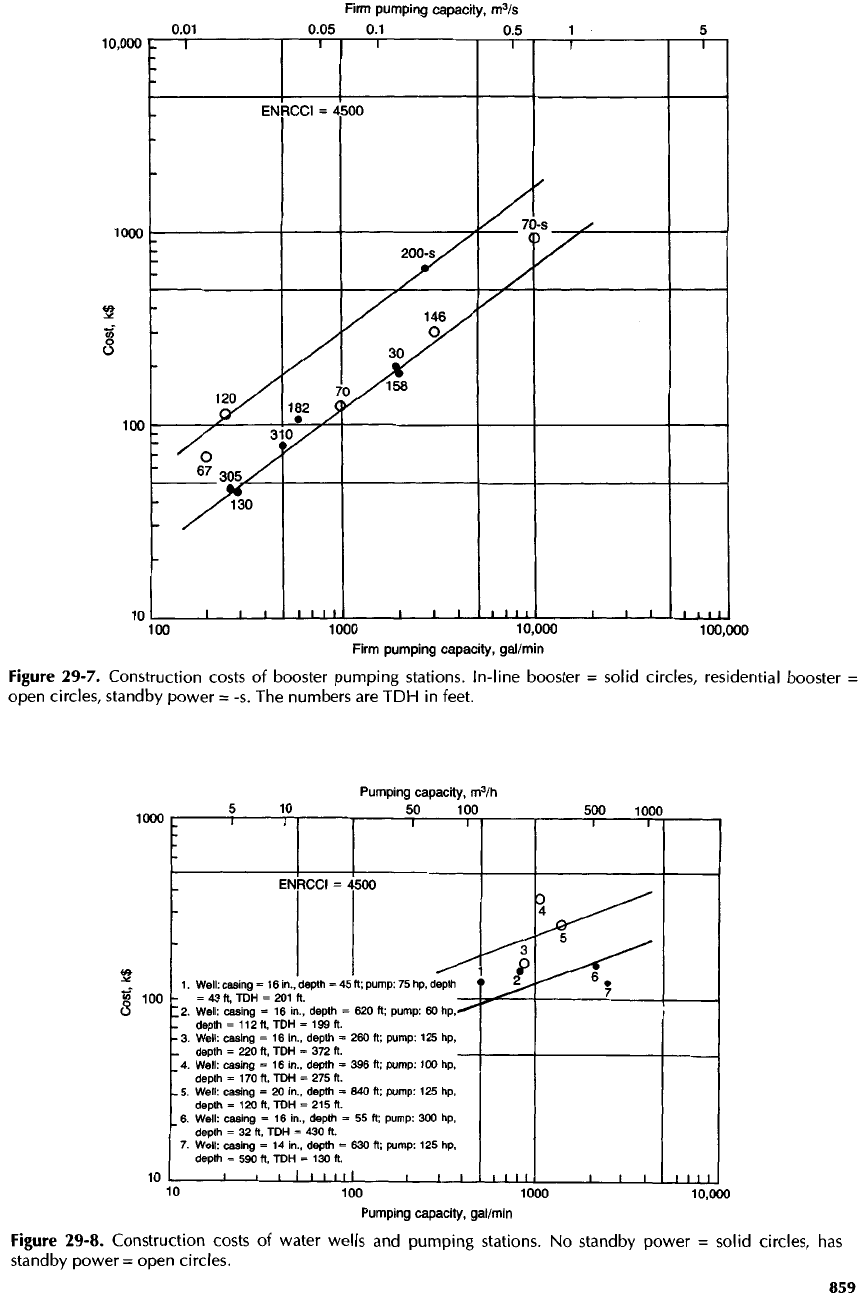
Figure
29-7. Construction
costs
of
booster
pumping
stations.
In-line
booster
=
solid circles, residential booster
=
open
circles,
standby power
= -s. The
numbers
are TDH in
feet.
Figure
29-8. Construction
costs
of
water wells
and
pumping
stations.
No
standby power
=
solid circles,
has
standby power
=
open circles.
